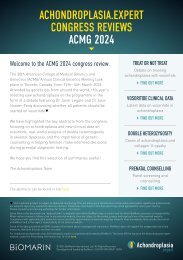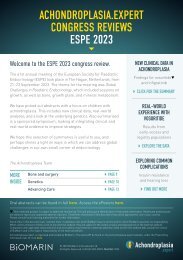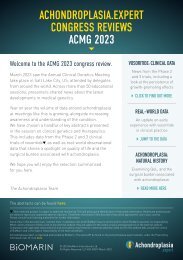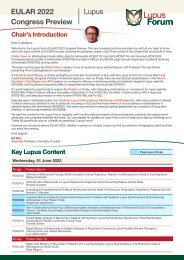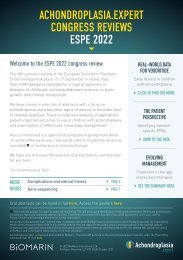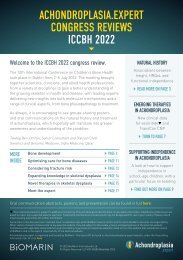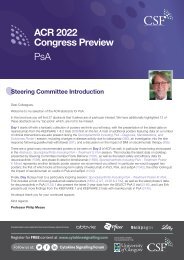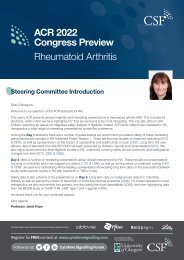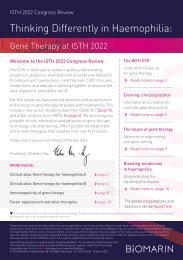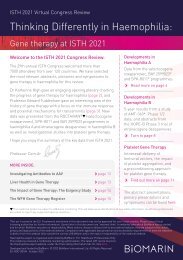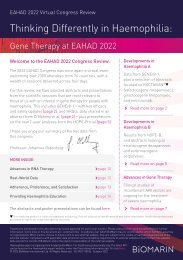EAHAD 2021 Congress Review
Create successful ePaper yourself
Turn your PDF publications into a flip-book with our unique Google optimized e-Paper software.
<strong>EAHAD</strong> <strong>2021</strong> <strong>Congress</strong> <strong>Review</strong><br />
Thinking Differently in Haemophilia:<br />
Gene therapy at <strong>EAHAD</strong> <strong>2021</strong><br />
Welcome to the <strong>EAHAD</strong> <strong>2021</strong> <strong>Congress</strong> <strong>Review</strong>.<br />
<strong>EAHAD</strong> <strong>2021</strong> was held as a virtual congress on 2–5 February<br />
<strong>2021</strong>, showcasing high-quality scientific research and<br />
dialogue, with engaging plenary sessions, symposiums<br />
and several posters focused on the topic of gene therapy.<br />
This review covers new data in gene therapy trials for<br />
haemophilia A and B, discussion of seroprevalence of NAbs,<br />
clearance of vector, details of the immune reaction in gene<br />
therapy and the perspectives of individual members of the<br />
MDT involved in the patient journey.<br />
We hope you enjoy this summary of gene therapy at<br />
the congress.<br />
Professor Víctor Jiménez Yuste<br />
MORE INSIDE:<br />
Novel therapies in haemophilia page 2<br />
The progression of gene therapy for haemophilia page 2<br />
Is integration a concern in gene therapy? page 13<br />
Symposiums review page 15<br />
The abstract presentations, plenary presentations and<br />
symposiums can be found here using your congress log in.<br />
Advances in haemophilia A<br />
Phase 1/2 results of TAK-754,<br />
SPK-8016 and seroprevalence<br />
to the BAY 2599023 capsid<br />
were presented.<br />
Read more on page 5<br />
Advances in haemophilia B<br />
Discussion of the Phase 3<br />
HOPE-B study, Phase 1/2<br />
results of FLT180a and<br />
AMT-060, and Phase 2b<br />
results of AMT-061.<br />
Turn to page 8<br />
The Exigency programme<br />
The UK-based programme,<br />
evaluating the expectations<br />
of gene therapy in the<br />
haemophilia community,<br />
presented abstracts from<br />
three sub-studies.<br />
Find out more on page 12<br />
This medicinal product is subject to additional monitoring. This will allow quick identification of new safety information. Healthcare professionals<br />
are asked to report any suspected adverse reactions.<br />
Treatments mentioned in this document may not be approved for use in your country. Please consult local licensing authorities for further<br />
information. Some links in this document are “external links” to websites over which BioMarin has no control and for which BioMarin assumes<br />
no responsibility. When visitors choose to follow a link to any external website, they are subject to the cookie, privacy and legal policies of the<br />
external website. Compliance with applicable data protection and accessibility requirements of external websites linked to from this website<br />
falls outside the control of BioMarin and is the explicit responsibility of the external website.<br />
Haemophilia.expert is organised and funded by BioMarin. For healthcare professionals only. The latest API<br />
can be found on the Haemophilia.expert website, under the Prescribing Information tab. Or click here.<br />
© 2022 BioMarin International Ltd. All Rights Reserved. EU-ROC-00185 October 2022<br />
1
<strong>EAHAD</strong> <strong>2021</strong> <strong>Congress</strong> <strong>Review</strong><br />
Novel Therapies in Haemophilia<br />
Professor Hervé Chambost chaired a plenary session that provided<br />
an overview of the novel therapies in use and on the horizon for the<br />
management of haemophilia, including gene therapy.<br />
Dr David Lillicrap reviewed FVIII biology and the<br />
pros and cons of alternative treatment options<br />
including non-FVIII replacement therapies and<br />
gene therapy to answer the question Will there<br />
be a role for FVIII concentrate in haemophilia in<br />
the future? The pros and cons of gene therapy<br />
were reviewed. A single administration offering<br />
long term treatment, the avoidance of peaks<br />
and troughs, and the potential that it may<br />
be less immunogenic than FVIII replacement<br />
therapies were cited as pros. The key<br />
downsides were presented as non-eligibility<br />
due to pre-existing anti-AAV immunity, early,<br />
usually transient hepatotoxicity, variability<br />
of attained factor levels, the potential for<br />
long term genotoxicity, and the uncertain<br />
durability of response, although Dr Lillicrap<br />
acknowledged that response up to 5 years<br />
is feasible. Dr Lillicrap concluded that<br />
there will be a place for FVIII replacement<br />
therapies in the future for the treatment of<br />
breakthrough bleeds, to obtain reliable levels<br />
of laboratory-measured haemostatic activity,<br />
to enable global access to therapy to manage<br />
haemophilia A and, speculatively, to address<br />
non-haemostatic functions.<br />
The Progression of Gene Therapy<br />
for Haemophilia<br />
There were several sessions at <strong>EAHAD</strong> <strong>2021</strong> demonstrating the progress<br />
of gene therapy, including an abstract providing a snapshot of gene therapy<br />
trials as of October 2020, a plenary session covering key Phase 3 data,<br />
an update on the development of the WFH Gene Therapy Register, and<br />
considerations for optimising sharing of knowledge in clinical practice.<br />
Moon and Moon presented an update on gene<br />
therapy clinical trials for haemophilia. As of<br />
October 2020 there were two completed and<br />
five terminated/suspended trials in HB, and<br />
30 ongoing/upcoming (17 HA, 13 HB). Three<br />
quarters of the trials listed were in Phase 1<br />
or 2, and all trials recruited participants with<br />
a severe phenotype, with moderately severe<br />
participants included in 14. Two trials included<br />
paediatric patients and one, participants with<br />
inhibitors. Of the terminated/suspended trials,<br />
none attributed discontinuation to safety<br />
findings. Of the ongoing HA trials, 13 include<br />
an AAV vector, three a lentiviral vector and one,<br />
cell therapy with a non-viral vector. In the HB<br />
trials 12 used an AAV vector and two a lentiviral<br />
vector. The authors concluded that publication<br />
of results from gene therapy trials will provide<br />
insight for future research. [ABS079]<br />
Dr Glenn Pierce reviewed Gene therapy in<br />
haemophilia: where are we now? He provided<br />
a brief overview of AAV as a vector and of the<br />
developments made in the AAV expression<br />
cassette. He outlined the progress made<br />
in both haemophilia A and B, commenting<br />
that stable expression up to 8 years had<br />
been observed following gene therapy with<br />
FIX, and that the introduction of FIX-Padua<br />
enabled high factor levels to be achieved. The<br />
results of the Phase 3 trial of etranacogene<br />
dezaparvovec (AAV5-Padua hFIX) up to<br />
1 year were presented (see Dr Steven Pipe’s<br />
presentation on p10). In the Phase 3 trial of<br />
ROCTAVIAN ® (valoctocogene roxaparvovec),<br />
(AAV5-FVIIISQ), FVIII expression was observed<br />
in most participants at 1 year, although an<br />
approximately 75% loss of expression over<br />
4 years in the Phase 1/2 study was observed.<br />
ROCTAVIAN ® is indicated for the treatment of<br />
severe haemophilia A in adult patients without<br />
a history of factor VIII inhibitors and without<br />
detectable antibodies to AAV5. Please read<br />
the ROCTAVIAN ® SmPC before prescribing.<br />
Dr Pierce presented the Phase 3 results,<br />
showing that FVIII stabilised at approximately<br />
30% by 20 weeks, although variability was<br />
observed with one participant experiencing up<br />
to 450 IU/dl and another 0 IU/dl. Of the first<br />
16 patients evaluated at the 1-year timepoint,<br />
two had no response to gene therapy. The<br />
median and mean ABR at 1 year was 0 and 0.8,<br />
respectively and 80% of participants were bleed<br />
free. All patients were receiving prophylactic<br />
FVIII at baseline, however by 1 year infusions<br />
were reduced to a median of 0 (mean of 2),<br />
and 67% of participants were infusion-free.<br />
Dr Pierce commented that the significance of<br />
elevated transaminases is less clear in FVIII<br />
than FIX; prednisolone appears less effective in<br />
managing elevations in ALT, and in managing<br />
any potential loss of FVIII activity. The shortand<br />
long-term safety considerations for<br />
gene therapy were reviewed and Dr Pierce<br />
Valoctocogene roxaparvovec Phase 3 results: FVIII activity levels for N=112 rollover population in the<br />
mild haemophilic range at 1 year 1<br />
Factor VIII Activity<br />
(IU/dL, chromogenic)<br />
500<br />
450<br />
400<br />
350<br />
300<br />
250<br />
200<br />
150<br />
100<br />
50<br />
0<br />
150 IU/dL<br />
50 IU/dL<br />
Baseline<br />
1–4 5–8 9–12 13–16 17–20 21–24 25–28 29–32 33–36 37–40 41–44 45–48 49–52<br />
Weeks<br />
Dr Glenn Pierce<br />
2 3
<strong>EAHAD</strong> <strong>2021</strong> <strong>Congress</strong> <strong>Review</strong><br />
outlined the need to understand how gene<br />
therapy works from a cellular and molecular<br />
perspective to improve safety and potentially<br />
to better comprehend the variability.<br />
Konkle et al outlined the development of<br />
the WFH gene therapy register (GTR), a<br />
prospective, observational and longitudinal<br />
registry designed to collect data on the<br />
long-term safety, variability and duration<br />
of efficacy after gene therapy, either as<br />
part of a clinical trial or post-approval.<br />
The GTR was developed in collaboration with<br />
ISTH, <strong>EAHAD</strong>, EHC, the US NHF, ATHN, and<br />
industry partners, through an iterative process<br />
with guidance from the EMA and FDA. The<br />
core data set is in press (Konkle et al 2020),<br />
and includes data on demographics, vector<br />
infusion, safety, efficacy and quality of life.<br />
WFH GTR Core Data Set<br />
Demographics<br />
Medical/Clinical History<br />
Gene Therapy Infusion Details<br />
Safety Data<br />
Adverse Events of Interest:<br />
FVIII/FIX Inhibitors<br />
Thromboembolic Events<br />
Autoimmune Disorders<br />
Malignancies<br />
Liver function<br />
Death<br />
Efficacy Data<br />
Bleeding Events<br />
Factor Activity Levels<br />
Use of Hemostatic Treatment<br />
Patient Reported Outcome Measures<br />
Quality of Life<br />
Burden of Disease<br />
Mortality<br />
Konkle et al [ABS203]<br />
Developed through an iterative process,<br />
and following guidance of the European Medicines<br />
Agency and the US Food and Drug Administration.<br />
Data will be collected at 3, 6, 9, 12, 18, and<br />
24 months either directly from haemophilia<br />
treatment centres or through existing<br />
haemophilia registries that meet outlined<br />
criteria, such as ATHN in the US. The registry<br />
will be ready to receive data mid-<strong>2021</strong>.<br />
The WFH GTR will enable rare adverse<br />
events in a small patient population over<br />
a large geographical area to be detected.<br />
Konkle et al concluded that the unknowns<br />
of gene therapy make it important that<br />
all those in the haemophilia community<br />
receiving gene therapy are followed up<br />
over their lifetime. [ABS203]<br />
Declan Noone, EHC President, reviewed<br />
the Delivery of gene therapy in haemophilia<br />
in Europe. He outlined that capturing and<br />
efficient reporting of data related to the<br />
rapid roll out of previous novel therapies has<br />
been challenging. With only a small number<br />
of patients likely to be treated with gene<br />
therapy there is the potential that patients<br />
and clinicians may lack information that is<br />
available in the healthcare system but that<br />
is not being shared in a timely and efficient<br />
way. Optimising outcomes for gene therapy<br />
will be essential, and this may be possible<br />
through the <strong>EAHAD</strong>/EHC hub-and-spoke<br />
model, with the hub collating all outcome<br />
data. This may enable greater understanding<br />
of response including capsid differences,<br />
variability, and immunosuppressant<br />
protocols. Mr Noone concluded that<br />
coordination and international collaboration,<br />
such as through the WFH GTR, will be<br />
essential in maximising limited data and<br />
ensuring that each patient is able to learn<br />
from the collective experience of all gene<br />
therapy patients who have gone before them.<br />
Advances in Gene Therapy for<br />
Haemophilia A<br />
Results from the Phase 1/2 studies of SPK-8016 and TAK-754 were<br />
presented, as was a study investigating the seroprevalence of NAbs against<br />
the capsid for BAY 2599023, and in vitro primary hepatocyte models to<br />
screen novel liver-targeted AAV capsids for transduction efficiency.<br />
Dr Spencer Sullivan presented data on the<br />
first four patients to complete 1 year follow<br />
up of SPK-8016: Preliminary results from a<br />
Phase 1/2 clinical trial of gene therapy for<br />
hemophilia A. This safety and dose finding<br />
study began at a dose of 5x10 11 vg/kg.<br />
The patients experienced no SAEs and<br />
no inhibitor development. FVIII levels<br />
were variable over the first 12 weeks and<br />
three participants experienced a decline<br />
in expression that prompted initiation of<br />
corticosteroid therapy. Steroid use exceeded<br />
4–5 months so steroid-sparing co-therapy<br />
was used to limit exposure. Dr Sullivan<br />
confirmed during the panel discussion that<br />
this is a standard approach for treating<br />
autoimmune hepatitis. One patient receiving<br />
azathioprine had elevated transaminases<br />
which resolved on discontinuation. One<br />
participant had isolated ALT elevations above<br />
the ULN at 11 and 15 months that did not<br />
correlate with a change in FVIII expression.<br />
FVIII activity levels of 5–6% at 1 year were<br />
approximately 4 times lower in participants<br />
who received corticosteroids than for the one<br />
who did not. Good preliminary durability was<br />
observed in all participants, and annualised<br />
infusion and bleeding rates were reduced by<br />
98% and 85%, respectively. Three patients<br />
receiving prophylaxis prior to gene therapy<br />
were able to discontinue use and one patient<br />
using on-demand therapy, with 18 bleeds in<br />
the year prior, experienced no bleeds after<br />
gene therapy. All patients converted to a<br />
mild phenotype. Dr Sullivan concluded that<br />
the ongoing trial of SPK-8016 demonstrated<br />
acceptable safety and sustained FVIII activity<br />
levels ranging from 5.9–21.8% at ≥52 weeks<br />
follow up.<br />
The results of an ongoing Phase 1/2 safety<br />
and dose-escalation study of TAK-754, a<br />
modified AAV8 capsid containing a BDD<br />
coagulation FVIII transgene with liver-specific<br />
promoter, were presented by Chapin et al.<br />
Four men with severe haemophilia A, who<br />
were using FVIII prophylaxis prior to the study,<br />
received an infusion of TAK-754 at a dose of<br />
2x10 12 cp/kg or 6x10 12 cp/kg (2 participants per<br />
cohort). All participants completed ≥10 months<br />
follow up. No infusion reactions, development<br />
of inhibitors or thrombosis were observed.<br />
Minor transaminase elevations were seen in<br />
all participants, and all received corticosteroids<br />
(n=3) or corticosteroid prophylaxis (n=1).<br />
A total of 61 AEs were reported, with 8 related<br />
to the product and 14 related to corticosteroid<br />
use. Dose-dependent FVIII expression<br />
4 5
<strong>EAHAD</strong> <strong>2021</strong> <strong>Congress</strong> <strong>Review</strong><br />
peaked 4–9 weeks following infusion<br />
(2x10 12 cp/kg, 3.8% and 11%; 6x10 12 cp/kg,<br />
54.7% and 69.4%), and significantly declined<br />
during tapering of corticosteroids. Three<br />
participants resumed FVIII prophylaxis.<br />
Analysis of the loss of FVIII expression is<br />
on-going. [ABS185]<br />
Ferrante et al investigated the seroprevalence<br />
of pre-existing NAbs and anti-drug antibodies<br />
(ADA) against AAVhu37, the capsid for<br />
BAY 2599023 (AAVhu37.hFVIIIco), a<br />
non-replicating AAV vector containing a<br />
single-stranded DNA genome encoding<br />
a BDD FVIII, driven by a liver-specific<br />
promoter/enhancer combination. In this<br />
Phase 1/2 study, 100 participants with<br />
severe haemophilia A with no detectable<br />
neutralising immunity against AAVhu37<br />
above a titer of 5, received a single infusion<br />
of BAY 2599023. Low seroprevalence was<br />
observed for both NAbs and ADAs with<br />
a maximum titer of 26 and 182 against<br />
AAVhu37, respectively. Five patients (83.3%)<br />
had durable and sustained FVIII levels,<br />
with cohorts 1 (0.5x10 13 gc/kg, n=2)<br />
2 (1.0x10 13 gc/kg, n=2) and 3 (2.0x10 13 gc/kg,<br />
n=2) completing 21, 16 and 11 months of<br />
follow up, respectively. Once protective<br />
levels of FVIII were achieved (>11 IU/dL)<br />
no spontaneous bleeds or bleeds requiring<br />
treatment were observed. No SAEs were<br />
reported in any cohort. The authors<br />
concluded that BAY 2599023 has broad<br />
eligibility in haemophilia A due to low<br />
seroprevalence to AAVhu37, a good safety<br />
profile and sustained FVIII expression.<br />
[ABS057]<br />
Liu et al presented the results of a study<br />
to evaluate whether an in vitro primary<br />
hepatocyte culture could predict in vivo<br />
liver-directed AAV-mediated FVIII expression<br />
in different species, and the effects of<br />
isotretinoin on FVIII expression. In vitro<br />
AAV transduction assays were developed<br />
in cultured primary hepatocytes from<br />
humans, mice, dogs and cynomolgus<br />
and rhesus monkeys. AAV5-human FVIII<br />
and a novel liver-targeting capsid were<br />
transduced into mouse, human, and<br />
NHP hepatocytes, and AAV5-canine FVIII<br />
transduced into mouse, dog, and human<br />
hepatocytes. Relative vector DNA and<br />
RNA levels across species obtained in vitro<br />
correlated with in vivo data. Isotretinoin<br />
had no effect on hFVIII-SQ vector DNA<br />
but hFVIII-SQ RNA was decreased by<br />
approximately 50%; removal of isotretinoin<br />
reversed this effect. hFVIII-SQ RNA was<br />
restored after approximately 4 days. Liu et al<br />
concluded that in vitro primary hepatocyte<br />
models may be valuable in screening novel<br />
liver-targeted AAV capsids for transduction<br />
efficiency, assessing variability of liverdirected<br />
AAV-mediated gene expression,<br />
and for evaluating MOAs mediating drug-drug<br />
interactions. [ABS020]<br />
Continuous isotretinoin exposure (A) and withdrawal after 4 days in transduced primary human hepatocytes (B)<br />
A)<br />
B)<br />
FVIII DNA/ug DNA<br />
FVIII DNA/ug DNA<br />
2.5 x 10 9<br />
2 x 10 9<br />
1.5 x 10 9<br />
1 x 10 9<br />
5 x 10 8<br />
0<br />
DNA<br />
**<br />
*<br />
3 x 10 9 1 x 10 5<br />
8 x 10 4<br />
2 x 10 9 6 x 10 4<br />
4 x 10 4<br />
1 x 10 9<br />
2 x 10 4<br />
0<br />
0<br />
Vehicle 5ng/ml 500ng/ml<br />
Vehicle 5ng/ml 500ng/ml<br />
Isotretinoin<br />
Isotretinoin<br />
*<br />
****<br />
Vehicle 5ng/ml 5ng/ml, 500ng/ml<br />
withdrawal<br />
Isotretinoin<br />
*P
<strong>EAHAD</strong> <strong>2021</strong> <strong>Congress</strong> <strong>Review</strong><br />
Advances for Gene Therapy in<br />
Haemophilia B<br />
Efficacy and safety results up to 5 years from the Phase 1/2 study of<br />
AMT-060 were presented, along with the 2-year follow-up data from<br />
the Phase 2b trial of etranacogene dezaparvovec (AMT-061), and the<br />
Phase 3 HOPE-B study. In addition the time to clearance from body<br />
fluids of fidanacogene elaparvovec, and results from a Phase 1/2 study<br />
to evaluate the safety and efficacy of FLT180a were reviewed.<br />
Leebeek et al presented the results of a<br />
Phase 1/2 study into the safety and efficacy<br />
of AMT-060 up to 5 years. AMT-060 is an<br />
AAV5 vector with codon-optimised wild-type<br />
human FIX gene and liver-specific promoter.<br />
Estimated mean annualized total<br />
FIX replacement (IU)<br />
400000<br />
350000<br />
300000<br />
250000<br />
200000<br />
150000<br />
100000<br />
50000<br />
0<br />
400000<br />
350000<br />
300000<br />
250000<br />
200000<br />
150000<br />
100000<br />
50000<br />
0<br />
354,800<br />
Cohort 1<br />
Pretreatment<br />
Year 1 Year 2 Year 3 Year 4 Year 5<br />
173,200<br />
82%<br />
64,000<br />
91% 83% 89% 84%<br />
31,700<br />
60,842<br />
Cohort 2<br />
38,026<br />
57,913<br />
78% 92% 96% 99% 99%<br />
38,600<br />
14,600 7,605 2,395 1,378<br />
Pretreatment<br />
Year 1 Year 2 Year 3 Year 4 Year 5*<br />
It was evaluated in 10 adult males with severe<br />
haemophilia who received a single infusion at<br />
a dose of 5x10 12 (cohort 1, n=5) or 2x10 13 gc/kg<br />
(cohort 2, n=5). Mean FIX activity in cohort 1<br />
and 2 was 5.2% and 7.4% at the 5- and<br />
Mean annualized total bleeds (n)<br />
Prophylaxis was tapered and discontinued by 12 weeks if FIX activity was maintained at ≥2%;<br />
*Cohort 2 data for year 5 represents 6 months.<br />
16<br />
14<br />
12<br />
10<br />
8<br />
6<br />
4<br />
2<br />
0<br />
16<br />
14<br />
12<br />
10<br />
8<br />
6<br />
4<br />
2<br />
0<br />
14.4<br />
Cohort 1<br />
47% 81% 57% 69% 55%<br />
Pretreatment<br />
Year 1 Year 2 Year 3 Year 4 Year 5<br />
4.0<br />
7.6<br />
2.8<br />
5.2<br />
Cohort 2<br />
4.4<br />
6.5<br />
65% 85% 80% 90% 100%<br />
1.4<br />
0.6 0.8 0.4 0<br />
Pretreatment<br />
Year 1 Year 2 Year 3 Year 4 Year 5*<br />
Leebeek et al [ABS043]<br />
4.5-year timepoint, respectively. By Year 5<br />
mean ABR was reduced by 55% and 100%<br />
from the year prior to treatment in cohort<br />
1 and 2 respectively, and FIX replacement<br />
consumption declined by 84% and 100%.<br />
Prophylaxis was discontinued in eight of<br />
nine participants using it prior to infusion.<br />
TRAEs were mainly reported in the first<br />
3.5 months; no participants developed<br />
inhibitors or signs of sustained AAV5<br />
capsid-specific T-cell activation. Durable,<br />
sustained FIX expression and reductions in<br />
ABR and FIX replacement were maintained<br />
up to 5 years. The authors concluded that<br />
these data support the ongoing Phase 3 trial<br />
of etranacogene dezaparvovec (AMT-061),<br />
which encodes the highly active Padua<br />
FIX variant. [ABS043]<br />
The 2-year follow-up data from a Phase 2b,<br />
open-label, single-dose (2x10 13 gc/kg),<br />
single-arm, multicentre trial of etranacogene<br />
dezaparvovec (AMT-061) was presented by<br />
Mean FIX activity over 2 years<br />
FIX activity one-stage aPTT<br />
(% of normal)<br />
70.0<br />
60.0<br />
50.0<br />
40.0<br />
30.0<br />
20.0<br />
10.0<br />
0<br />
0<br />
von Drygalski et al. Etranacogene<br />
dezaparvovec combines the Padua FIX<br />
variant with the AAV5-WT-hFIX from AMT-060.<br />
At baseline all three participants had FIX ≤1%,<br />
needed routine prophylaxis and had<br />
neutralising activity to AAV5. By Week 6<br />
mean FIX activity had increased to 31%<br />
and by Week 52 to 41%, with no relationship<br />
seen between the response to treatment<br />
and the presence of anti-AAV NAbs.<br />
Mean FIX activity at 2 years was 44.2%.<br />
Over 2 years, 1 participant has used a total<br />
of 2 infusions of FIX replacement therapy<br />
(1 suspected and 1 confirmed bleed) on<br />
separate occasions (excluding surgery).<br />
There was no loss of FIX activity over 2 years<br />
and no need for immunosuppression. In<br />
addition, no participant developed inhibitor to<br />
FIX. Sustained FIX activity was demonstrated<br />
in participants with AAV5 NAbs receiving a<br />
single dose of etranacogene dezaparvovec,<br />
and all were able to discontinue routine<br />
prophylaxis. [ABS100]<br />
Participant 1<br />
Participant 2<br />
Participant 3<br />
4 8 12 16 20 24 28 32 36 40 44 48 52 56 60 64 68 72 76 80 84 88 92 96 100 104<br />
Week<br />
No immunosuppression required. † The week 0 time point reflects FIX activity before etranacogene dezaparvovec treatment.<br />
*Samples may include activity from exogenous FIX replacement.<br />
von Drygalski et al [ABS100]<br />
51.6<br />
44.7<br />
36.3<br />
8 9
<strong>EAHAD</strong> <strong>2021</strong> <strong>Congress</strong> <strong>Review</strong><br />
Overview of FIX activity up to 26 weeks<br />
FIX activity. central one-stage (%)<br />
100<br />
90<br />
80<br />
70<br />
60<br />
50<br />
40<br />
30<br />
20<br />
10<br />
0<br />
1 2 3 4 5 6 7 8 9 10 11 12<br />
Month 4 Month 5 Month 6<br />
Week<br />
N<br />
52 51 53 48 51 51 47 45 49 52<br />
50 47 54<br />
Mean (SD) FIX activity at Month 6: 37.2% (19.6); change from baseline +36.01% (19.693), p
<strong>EAHAD</strong> <strong>2021</strong> <strong>Congress</strong> <strong>Review</strong><br />
Results from the Exigency Programme<br />
The Exigency programme explores the expectations of gene therapy in the<br />
UK haemophilia community. Results from sub-studies were presented on<br />
topics including the knowledge and expectation of gene therapy among<br />
parents of young children with haemophilia, why some people have no<br />
interest in gene therapy, and healthcare professionals’ experience of<br />
supporting people undergoing gene therapy.<br />
Fletcher et al presented the results of a<br />
survey exploring parent’s knowledge and<br />
expectations of gene therapy. A total of<br />
63 responses were received with 95%<br />
of respondents aware of gene therapy.<br />
People learnt about gene therapy through<br />
haemophilia social media, treatment<br />
centres, news media, patient groups and<br />
via general social media. A total of 84% were<br />
generally positive about gene therapy, with<br />
28% feeling they had a good understanding<br />
of it; 42% had thought a lot about it for their<br />
child, and 22% of parents reported that their<br />
child had asked if they could have gene<br />
therapy. 88% of parents would consider<br />
gene therapy for their child, although only<br />
11% were aware that it might soon be available<br />
outside of clinical trials, with 37% aware<br />
that it is not available for children. Parents<br />
were aware of the life-changing nature of<br />
gene therapy but demonstrated uncertainty<br />
about outcomes and safety. The authors<br />
summarised that while many respondents<br />
had considered the possibility of gene therapy<br />
for their children, they experienced pressure<br />
to make the right decision, were reluctant to<br />
change existing treatment, and felt confused<br />
and uncertain due to the fragmented nature of<br />
communication on gene therapy. [ABS106]<br />
The results of a sub-study of 10 men with<br />
severe haemophilia who were not interested<br />
in gene therapy were presented by Fletcher<br />
et al. All were receiving prophylaxis and<br />
reported no treatment burden and minimal<br />
bleeding episodes in the previous 12 months.<br />
Five key themes emerged as to why they<br />
would decline gene therapy: 1. Self-identity<br />
as a person with haemophilia, and possible<br />
loss thereof; 2. Concerns over lack of longterm<br />
safety and efficacy data; 3. Lack of<br />
treatment burden on current therapy and<br />
concern over the burden of gene therapy;<br />
4. Ongoing concern over past history of<br />
viruses in the community; 5. Side effects<br />
of immune suppression and loss of gene<br />
expression. The authors concluded that<br />
access to safety and efficacy data as it is<br />
published will be beneficial for the patient<br />
community, as will education to support<br />
informed decision making. The psychological<br />
dynamic around self-identity is considered by<br />
the authors as an area that requires further<br />
exploration to enable appropriate support for<br />
those considering gene therapy. [ABS293]<br />
Pollard et al reported the results of a<br />
sub-study evaluating the experience of<br />
healthcare professionals directly involved<br />
in providing support to participants in gene<br />
therapy clinical trials. A mediated discussion<br />
was held with six haemophilia nurses,<br />
two consultant haematologists, and one<br />
physiotherapist. Challenges communicating<br />
with the research teams were raised. From<br />
a nursing perspective, there was uncertainty<br />
over the ability of participants to adhere to<br />
monitoring requirements following gene<br />
therapy and most felt they lost contact with<br />
their patients during the early trial phase,<br />
which is a key point in their care. Screening<br />
for psychological and emotional health issues<br />
prior to gene therapy and ongoing support<br />
were limited in many cases and nurses<br />
reported that participants can struggle to<br />
adapt to life as a person without haemophilia.<br />
Patient information provided as part of<br />
clinical trials was thought to be too detailed,<br />
however patients lacked understanding that<br />
pre-existing conditions such as arthropathy<br />
would be unaffected by gene therapy and that<br />
they could still pass the condition on. Little<br />
is known about people who were deemed not<br />
eligible for gene therapy. The outcomes of<br />
the study suggest that closer communication<br />
between the HTCs and research teams<br />
would be beneficial, as would addressing<br />
educational gaps and further research into<br />
the mental health implications of inclusion<br />
or exclusion from gene therapy clinical trials.<br />
[ABS292]<br />
Is Integration a Concern in Gene Therapy?<br />
Whether toxicity is a concern after gene therapy was discussed and<br />
integration was investigated in a canine model.<br />
Dr Denise Sabatino spoke on the topic<br />
Is long-term toxicity an issue after AAV<br />
gene therapy? Vector genome integration<br />
events, although rare, have been observed<br />
in mice, NHP and humans. In neonatal<br />
mouse models, dose dependent integration<br />
of viral genomes into the RNA was associated<br />
with HCC. A previous study of haemophilia<br />
A dogs showed two that had a rise in FVIII<br />
expression that was 4 times the steady<br />
state level after approximately 4 years<br />
and continued to rise until the end of the<br />
study. The increase was not associated with<br />
abnormal liver biomarkers, and clinically<br />
the dogs had no evidence of malignancy.<br />
AAV integration and clonal expansion<br />
might have been a potential mechanism<br />
for the observed increase in expression.<br />
DNA analysis identified approximately<br />
1700 unique integration events, distributed<br />
throughout the canine genome, with the<br />
number correlating to the vector copy<br />
number, and with integration favoured in<br />
transcription units and oncogenes. The<br />
structures identified were truncated or<br />
rearranged, however, it is possible that a<br />
full-length integrated event expanded and<br />
may explain the increased FVIII expression.<br />
There was no evidence of tumorigenesis.<br />
The site of integration may be more important<br />
than the number of integration events.<br />
Dr Sabatino concluded that studies using<br />
specific methods of analysis are needed to<br />
better understand integration events.<br />
12 13
<strong>EAHAD</strong> <strong>2021</strong> <strong>Congress</strong> <strong>Review</strong><br />
Dr Paul Batty presented the Characterisation<br />
of adeno-associated virus vector persistence<br />
after long-term follow up in the haemophilia A<br />
dog model. There are many questions on how<br />
AAV vectors persist and result in transgene<br />
expression, whether predominantly as<br />
non-integrated episomal forms, or integrated<br />
into the host genome. A total of eight dogs<br />
were treated with a wt-BDD canine FVIII AAV<br />
construct administered via a single portal<br />
vein infusion at doses of between 6x10 12 and<br />
2.7x10 13 vg/kg. Follow up was for a mean of<br />
10.7 years. Treatment response was seen<br />
in six, with stable FVIII levels observed<br />
throughout the study and a mean terminal<br />
chromogenic FVIII activity of 5.7%. Persistent<br />
AAV vector genomes were present in the liver<br />
at post-mortem in all dogs. Episomal AAV was<br />
the predominant vector form detected after<br />
8–12 years (95.4%). Integration events were<br />
observed in all dogs and all samples studied.<br />
Mean integration frequency was 9.55x10 -4<br />
integration sites/cell, which is similar to the<br />
frequency reported in shorter follow up in<br />
NHP and humans. This frequency is lower<br />
than that described for lentiviral vectors.<br />
94% of integration occurred in intergenic<br />
regions of the genome, with events clustered<br />
more commonly in some sites than others.<br />
AAV vector insertions were not random and<br />
occurred repeatedly in selected regions, with<br />
KCNIP2, CLIC2, ABCB1 and F8 common sites.<br />
Despite finding common integration events<br />
there was no evidence of liver adenoma or<br />
carcinoma post-mortem. Dr Batty highlighted<br />
the importance of further studies in a research<br />
setting to investigate integration in humans<br />
to begin to understand its relevance.<br />
Symposiums review<br />
There were seven symposiums held at <strong>EAHAD</strong> <strong>2021</strong>, two of which included<br />
content specific to gene therapy, covering experience from the MDT in clinical<br />
trials and addressing the known unknowns.<br />
Thinking differently in haemophilia: considerations<br />
for the multidisciplinary team in gene therapy,<br />
experience from clinical trials<br />
This symposium, sponsored by BioMarin, was chaired by Professor Wolfgang Miesbach and<br />
focused on the role that different members of the MDT play in the gene therapy patient journey,<br />
including the perspectives of a physician, a nurse, a physiotherapist and a psychologist.<br />
Professor Miesbach outlined that the MDT has<br />
specific roles and a shared responsibility in<br />
supporting the gene therapy patient journey,<br />
and that the key to success will be collaboration.<br />
This will be especially important in the<br />
<strong>EAHAD</strong>-EHC proposed hub-and-spoke model,<br />
which was reviewed. Professor Miesbach<br />
elaborated on the physician’s role prior<br />
to, during and after gene therapy and the<br />
different responsibilities of the physician<br />
at the hub vs the spoke centre. Ensuring<br />
shared, informed decision-making is vital<br />
given that the treatment cannot be reversed.<br />
Key discussions between the physician and<br />
the patient should include how gene therapy<br />
works, the uncertainties of duration, long-term<br />
safety, eligibility and response, the importance<br />
of adherence to follow up, monitoring and<br />
treating ALT elevation, and necessary lifestyle<br />
changes in the short term. One of the main<br />
responsibilities of the physician is coordination,<br />
which, with effective communication between<br />
all members of the MDT across all relevant<br />
centres, will be critical in the gene therapy<br />
patient journey. Some questions remain for<br />
the hub-and-spoke model, such as which<br />
centre is responsible at which stage, who is<br />
responsible for follow up care and guidance<br />
and how decisions relating to lab results<br />
and AEs are made. Over time networking<br />
between hub centres could optimise care,<br />
with sharing of knowledge helping centres<br />
to develop their own service.<br />
Sara García Barcenilla presented the nurse’s<br />
experience. Prior to gene therapy, the role<br />
of the nurse is to support the patient in the<br />
shared decision-making process, including<br />
discussing the variability of FVIII level and<br />
expression, any doubts the patient may<br />
have, planning follow up and ensuring the<br />
patient is aware that an immunosuppression<br />
plan is in place, if necessary. Sara García<br />
Barcenilla discussed appropriate support for<br />
a patient on infusion day, including details<br />
of samples to be taken, the time needed in<br />
14 15
<strong>EAHAD</strong> <strong>2021</strong> <strong>Congress</strong> <strong>Review</strong><br />
hospital and practical considerations. Home<br />
nursing services and fluent communication<br />
with the HTC can provide support to ensure<br />
participation in gene therapy is as easy and<br />
flexible as possible, with training for patients<br />
to detect early symptoms of increases in<br />
transaminases. Managing patient expectations<br />
and fears is a key role for the nurse, and Sara<br />
García Barcenilla presented interesting data on<br />
managing doubts and complications showing<br />
that patients felt reassured by direct contact<br />
with their physician, nurse or research team.<br />
Dr Sébastian Lobet presented the<br />
physiotherapist’s experience of gene therapy,<br />
with focus on monitoring, education, treatment<br />
and shared decision-making. More sensitive<br />
ways to assess the patient may be needed<br />
after gene therapy, such as gait analysis,<br />
balance or proprioception assessment, or<br />
new tools with better clinimetric properties.<br />
With factor levels heterogenous in different<br />
patients, it is unknown what level of factor is<br />
needed to protect a particular patient during<br />
activities of daily life or during physical activity.<br />
The impact of a constant factor level achieved<br />
by gene therapy may lead a patient to become<br />
overconfident and to take excessive risks.<br />
Physiotherapists will need to educate patients<br />
on what activities they can do with a constant<br />
level of factor. For those with already damaged<br />
joints, continued physiotherapy will be<br />
important after gene therapy. Physiotherapists<br />
know patients well and understand their<br />
personal aspirations and difficulties. There<br />
is an important role for the physiotherapist<br />
in shared decision making when considering<br />
if a patient is an appropriate candidate for<br />
gene therapy, in relation to their levels of<br />
motivation to adhere to follow up.<br />
Dr Gaby Golan gave his insight on the<br />
psychological considerations for gene<br />
therapy including a patient’s motivations,<br />
their compliance and dedication to follow<br />
up, whether their expectations meet reality<br />
and whether they are mentally capable of<br />
going through the process. Patients will likely<br />
require psychological support for adjusting<br />
to a new self-identity, loss of contact with the<br />
haemophilia centre, loss of belonging to the<br />
haemophilia community, and with concerns<br />
about a novel therapy. Uncertainty over the<br />
duration and variability of treatment, fear over<br />
loss of expression and knowing that daughters<br />
will still be carriers of haemophilia may be a<br />
lot for a patient to take on; the psychologist’s<br />
role is to prepare them and ensure they have<br />
the capacity to cope with whatever outcomes<br />
they experience. Dr Golan considered that<br />
psychology teams must be involved in all stages<br />
of gene therapy as part of the coordinated MDT.<br />
Professor Miesbach concluded by stating<br />
that MDT collaboration is key to optimise<br />
an individualised treatment approach in<br />
gene therapy.<br />
Physiotherapist roles in the gene therapy<br />
patient journey<br />
Shared<br />
decision<br />
Monitoring<br />
Treatment<br />
Education<br />
Dr Sébastian Lobet<br />
Addressing the known unknowns: how long-term<br />
follow up is evolving our scientific understanding of<br />
haemophilia gene therapy<br />
This symposium, sponsored by Pfizer, was chaired by Professor Mike Laffan and Ian Winburn<br />
(Pfizer) and addressed the known unknowns of gene therapy including the potential impact on<br />
the liver, the immune response and the psychological considerations for supporting a patient.<br />
Professor Mike Laffan provided an update<br />
on the current status of AAV-mediated gene<br />
therapies in haemophilia. He commented<br />
that future advances may include using<br />
alternative vectors such as lentivirus, targeted<br />
intervention or non-viral vectors such as<br />
liposomes. Professor Laffan discussed the<br />
known unknowns of gene therapy including<br />
efficacy considerations such as the variability<br />
and determinant of response, duration of<br />
effect, whether children can be treated and<br />
whether retreatment is a possibility. From a<br />
safety perspective he stated that outstanding<br />
questions remain as to the nature of the<br />
immune and hepatic responses, whether<br />
it will be safe to treat inhibitor patients,<br />
whether off-target tissues will be affected,<br />
and what the danger of integration is.<br />
Biopsies and improved laboratory animal<br />
models are a potential source for addressing<br />
some of these unknowns.<br />
Professor Heiner Wedemeyer provided a<br />
hepatologist’s view. He commented that<br />
AAV-mediated gene therapy for haemophilia<br />
A may be limited by the ability of hepatocytes<br />
to fully synthesise and secrete FVIII (primarily<br />
synthesised by hepatic sinusoidal endothelial<br />
cells). He outlined three key aspects, from<br />
a hepatology perspective, when considering<br />
a candidate for gene therapy: whether<br />
there is a risk of acute toxicity, if there<br />
is an issue regarding long term safety<br />
and which comorbidities are present<br />
that may impact the efficacy or safety<br />
of gene therapy. Professor Wedemeyer<br />
commented that the risk for acute hepatitis<br />
is not the major concern for hepatologists<br />
as it can be managed with corticosteroids,<br />
and 10-year follow up of dogs receiving<br />
AAV gene therapy did not reveal any late<br />
onset hepatitis. He discussed concerns<br />
over clonal expansion and referenced long<br />
term data in dogs that showed some level<br />
of clonal expansion of transduced liver cells<br />
but no development of HCC. He noted that<br />
the risk of cancer from gene therapy is low<br />
in his opinion, but that underlying liver<br />
diseases need to be considered more<br />
carefully. Professor Wedemeyer concluded<br />
that more data will enable greater<br />
understanding of what is happening in<br />
the liver long term after gene therapy.<br />
Professor Thierry VandenDriessche<br />
addressed the immunological challenges<br />
of gene therapy, in that the immune<br />
system can potentially intervene at all<br />
stages, from neutralising the vector<br />
particles, to clearing the gene-modified<br />
hepatocytes, and recognising the therapeutic<br />
proteins secreted by the cells. He noted<br />
16 17
<strong>EAHAD</strong> <strong>2021</strong> <strong>Congress</strong> <strong>Review</strong><br />
that pre-existing antibodies can elicit a<br />
greater immune response and interfere<br />
with the efficacy of gene transfer. This may<br />
be avoided by modifying the AAV capsid,<br />
by removing the antibodies, or subjecting<br />
the patient to immune suppression. He<br />
commented that even with vector engineering<br />
and recent advances in antibody degradation<br />
using IgG-specific proteases and IdeS,<br />
if the anti-AAV Ab titer is very high, it will<br />
be challenging to overcome. Professor<br />
VandenDriessche demonstrated evidence<br />
from trials which indicate that a cellular<br />
immune response may account for loss<br />
of hepatocytes, the mechanism for which<br />
is unknown. During the panel discussion<br />
Professor VandenDriessche discussed that it<br />
may be feasible to administer a dose of vector<br />
low enough that T cells do not recognise<br />
the vector and trigger the immune system;<br />
there is rationale for developing more potent<br />
vectors to offset low doses, such as the use<br />
of Padua in AAV-FIX gene therapy.<br />
Dr Nicola Dunn addressed the uncertainties<br />
that may exist for patients who opt for gene<br />
therapy, including duration of expression,<br />
long term safety, and the potential for toxicity,<br />
an immune response or liver complications.<br />
Practical factors with psychological<br />
implications include the significant time<br />
commitment for follow up, the change in<br />
haemophilia management, feelings of risk<br />
associated with not taking factor for physical<br />
activity, and the remaining presence of joint<br />
pain and arthropathy. Dr Dunn addressed the<br />
adjustment that a PwH may need to make<br />
after gene therapy that they are no longer a<br />
person with severe haemophilia and that this<br />
may affect their self-concept and self-esteem.<br />
The impact on partners and children was<br />
discussed as was how feelings of belonging<br />
to the HTC and haemophilia community may<br />
be affected. Dr Dunn concluded by stating<br />
that clear communication is needed with<br />
patients and families at all stages of the<br />
gene therapy patient journey.<br />
LIST OF ABBREVIATIONS<br />
AAV – adeno-associated virus<br />
ABR – annualised bleeding rate<br />
ADA – anti-drug antibodies<br />
ALT – alanine aminotransferase<br />
aPTT – activated partial<br />
thromboplastin time<br />
ATHN – American Thrombosis and<br />
Hemostasis Network<br />
bCG – beta-chorionic gonadotropin<br />
BDD – B-domain deleted<br />
cp/kg – capsid particles/kilogram<br />
<strong>EAHAD</strong> – European Association for<br />
Haemophilia and Allied Disorders<br />
EHC – European Haemophilia<br />
Consortium<br />
EMA – European Medicines Agency<br />
FDA – US Food and Drug<br />
Administration<br />
gc – genome copies<br />
GTR – gene therapy register<br />
HCC – hepatocellular carcinoma<br />
HTC – Haemophilia Treatment Centre<br />
ISTH – International Society of<br />
Thrombosisand Hemostatis<br />
MOA – mechanism of action<br />
MDT – multidisciplinary team<br />
NAb – neutralising antibody<br />
NHP – non-human primate<br />
PBMCs – peripheral blood<br />
mononuclear cells<br />
PwH – person with haemophilia<br />
TRAE – treatment-related<br />
adverse event<br />
ULN – upper limit of normal<br />
US NHF – US National Hemophilia<br />
Foundation<br />
vg/kg – vector genomes/kilogram<br />
WFH – World Federation of Hemophilia<br />
REFERENCES<br />
1. BioMarin JP Morgan <strong>2021</strong> presentation. https://investors.biomarin.com/events-presentations?item=97<br />
(Accessed 24 February <strong>2021</strong>).<br />
18



